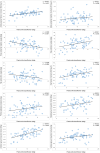The relationship of peak ankle dorsiflexion angle with lower extremity biomechanics during walking
- PMID: 38812103
- PMCID: PMC11296718
- DOI: 10.1002/jfa2.12027
The relationship of peak ankle dorsiflexion angle with lower extremity biomechanics during walking
Abstract
Purpose: Abnormal lower limb movement patterns have been observed during walking in individuals with limited ankle dorsiflexion. The purpose of this study was to investigate the relationships of peak ankle dorsiflexion angle during the stance phase of walking with the lower extremity biomechanics at the corresponding moment and to determine a cutoff value of functional limited ankle dorsiflexion during walking.
Methods: Kinematic and kinetic data of 70 healthy participants were measured during walking. Spearman's correlation coefficients were calculated to establish the association between peak ankle dorsiflexion and angle and moment of ankle, knee, and hip, ground reaction force, and pelvic movement at peak ankle dorsiflexion. All variables significantly related to peak ankle dorsiflexion were extracted as a common factor by factor analysis. Maximally selected Wilcoxon statistic was used to perform a cutoff value analysis.
Results: Peak ankle dorsiflexion positively correlated with ankle plantar flexion moment (r = 0.432; p = 0.001), ankle external rotation moment (r = 0.251; p = 0.036), hip extension angle (r = 0.281; p = 0.018), hip flexion moment (r = 0.341; p = 0.004), pelvic ipsilateral rotation angle (r = 0.284; p = 0.017), and medial, anterior, and vertical ground reaction force (r = 0.324; p = 0.006, r = 0.543; p = 0.001, r = 0.322; p = 0.007), negatively correlated with knee external rotation angle (r = -0.394; p = 0.001) and hip adduction angle (r = -0.256; p = 0.032). The cutoff baseline value for all 70 participants was 9.03°.
Conclusions: There is a correlation between the peak ankle dorsiflexion angle and the lower extremity biomechanics during walking. If the peak ankle dorsiflexion angle is less than 9.03°, the lower limb movement pattern will change significantly.
Keywords: biomechanics; limited ankle dorsiflexion; pelvic movement; walking.
© 2024 The Author(s). Journal of Foot and Ankle Research published by John Wiley & Sons Australia, Ltd on behalf of Australian Podiatry Association and The Royal College of Podiatry.
Conflict of interest statement
The authors declare that the research was conducted in the absence of any commercial or financial relationships that could be construed as a potential conflict of interest.
Figures


Similar articles
-
Effects of peak ankle dorsiflexion angle on lower extremity biomechanics and pelvic motion during walking and jogging.Front Neurol. 2024 Feb 1;14:1269061. doi: 10.3389/fneur.2023.1269061. eCollection 2023. Front Neurol. 2024. PMID: 38362013 Free PMC article.
-
Effects of different slopes on hip and ankle biomechanics of replaced and non-replaced limbs of patients with total knee arthroplasty during incline ramp walking.J Biomech. 2024 Jul;172:112205. doi: 10.1016/j.jbiomech.2024.112205. Epub 2024 Jun 21. J Biomech. 2024. PMID: 38955092
-
Gait strategies to reduce the dynamic joint load in the lower limbs during a loading response in young healthy adults.Hum Mov Sci. 2018 Apr;58:260-267. doi: 10.1016/j.humov.2018.03.002. Epub 2018 Mar 12. Hum Mov Sci. 2018. PMID: 29524851
-
Contributions to the understanding of gait control.Dan Med J. 2014 Apr;61(4):B4823. Dan Med J. 2014. PMID: 24814597 Review.
-
Progressive Changes in Walking Kinematics and Kinetics After Anterior Cruciate Ligament Injury and Reconstruction: A Review and Meta-Analysis.J Athl Train. 2017 Sep;52(9):847-860. doi: 10.4085/1062-6050-52.6.06. J Athl Train. 2017. PMID: 28985125 Free PMC article. Review.
References
-
- Kang, M.‐Hyeok , Oh J.‐Seop, Kwon Oh‐Yun, Weon J.‐Hyuk, An D.‐Hyun, and Yoo W.‐Gyu. 2015. “Immediate Combined Effect of Gastrocnemius Stretching and Sustained Talocrural Joint Mobilization in Individuals with Limited Ankle Dorsiflexion: A Randomized Controlled Trial.” Manual Therapy 20(6): 827–834. 10.1016/j.math.2015.03.016. - DOI - PubMed
-
- Hoch, Matthew C. , Andreatta Richard D., Mullineaux David R., English Robert A., Medina McKeon Jennifer M., Mattacola Carl G., and McKeon Patrick O.. 2012. “Two‐week Joint Mobilization Intervention Improves Self‐Reported Function, Range of Motion, and Dynamic Balance in Those with Chronic Ankle Instability.” Journal of Orthopaedic Research 30(11): 1798–1804. 10.1002/jor.22150. - DOI - PubMed
-
- Kaufman, Kenton R. , Brodine Stephanie K., Shaffer Richard A., Johnson Chrisanna W., and Cullison Thomas R.. 1999. “The Effect of Foot Structure and Range of Motion on Musculoskeletal Overuse Injuries.” The American Journal of Sports Medicine 27(5): 585–593. 10.1177/03635465990270050701. - DOI - PubMed
MeSH terms
Grants and funding
LinkOut - more resources
Full Text Sources

